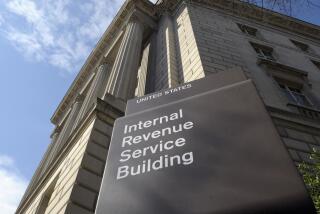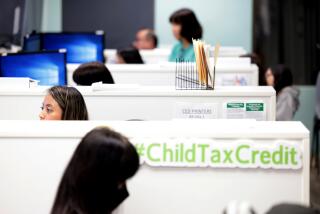More Tax Breaks, More Risk of Missing Them
As the U.S. Tax Code has become increasingly freckled with deductions and credits that kick in only at certain times and for certain people, the chances of missing a tax break have risen substantially, tax experts say.
“It’s like a roller-coaster ride,” said Roger Stinnett, senior manager at Ernst & Young in Los Angeles. “You’ve got all these deductions where it’s ‘Now you see them, now you don’t.’ If people aren’t paying close attention, they may miss a benefit.”
The General Accounting Office estimates that individual taxpayers miss out on an average $400 in savings because of deductions, credits and income exclusions they failed to claim. In years when there are significant changes -- and there was a laundry list of changes in 2003 -- the mistakes can become bigger and more costly, experts maintain.
Consider, for example, the “clean fuel” deduction available to thousands of buyers of gasoline-electric hybrid vehicles in 2003. This deduction can reduce taxable income by $2,000. That’s worth about $560 in tax savings to someone in the 28% federal tax bracket. And yet, experts note, it’s extremely easy to miss because there’s no mention of it on the 1040 form.
“If you are entitled to the deduction, you have to write it in,” said Mark Luscombe, principal tax analyst with CCH Inc., a Riverwoods, Ill., publisher of tax information.
Another write-off that’s a write-in involves so-called Archer Medical Savings Accounts. These are savings plans that people with high medical insurance deductibles can open to help them pay those deductibles. Taxpayers with the maximum deductible -- about $5,000 for a family plan -- can write off about $3,800 of that amount.
Starving artists also might be surprised to know that a special tax break has been carved out for them. The deduction for “performing arts-related expenses” does not appear on the 1040, but it’s available for those who worked for at least two employers, had business expenses that exceeded 10% of the income received for those services and earned less than $16,000.
Where are these deductions claimed? They are supposed to be written onto the blank space on Line 33 of the 1040, Luscombe said. What about people who can claim more than one?
“Write small,” Luscombe suggested. And of course, you could always attach a separate sheet of paper.
But it’s not just the obscure deductions that get overlooked, said Phil Holthouse, partner at Santa Monica tax law and accounting firm Holthouse Carlin & Van Trigt. Taxpayers often forget to deduct what they pay for state disability insurance, he said.
Taxpayers are generally good at claiming the state income tax payments listed on their W-2 statements, Holthouse added, but when they have to write a check to state authorities for an underpayment of the previous year’s tax, they frequently forget to include that amount.
Noncash charitable contributions are another big missed item, he said. This is a deduction for the market value of old clothing, furniture or housewares given to charity during the year.
Many families give away hundreds of dollars’ worth of goods and simply don’t bother to keep records allowing them to claim the tax write-off, experts say. But each $100 in used clothing given to a cause, for example, is worth $28 in tax breaks for a person in the 28% bracket. Consider it a bonus for cleaning out the closets.
Tax experts at Jackson Hewitt break the most overlooked deductions into categories -- one for employees with work- related expenses, one for the self-employed and one for the unemployed.
Those who have lost jobs, for example, may not know that the fees and commissions paid to employment agencies and job counselors are deductible. So are the costs associated with preparing and mailing resumes.
Self-employed individuals can deduct half the self-employment tax they pay; lodging, transportation, meals and laundry services used while traveling on business; legal and professional fees; and business gifts of up to $25 per customer.
Employees can deduct dues paid to unions and professional organizations; cellular phone charges for business calls; the cost of newspaper and magazine subscriptions used for business; the cost of buying and maintaining work clothes and uniforms; education expenses to improve or maintain job skills; and tools and equipment bought for work.
Experts at H&R; Block, the big tax preparation company, believe that taxpayers may forget to claim relatively new education deductions, such as the write-off of as much as $2,500 for student loan interest paid and the deduction of up to $3,000 for paying qualified higher education expenses.
While taxpayers have every incentive to claim every deduction and credit possible, these are often overlooked because many of them are relatively new. Others, like summer fruit, will be around for only a short time. The education expense deduction, which launched in 2002, sunsets in 2005, for example.
“My theory is that Congress is so embarrassed about the mockery that they have made of the Tax Code that they try to embarrass tax preparers by making them miss at least some of these by putting them in and taking them out, phasing them in and phasing them out,” said Holthouse. “It’s a new challenge every year.”
More to Read
Inside the business of entertainment
The Wide Shot brings you news, analysis and insights on everything from streaming wars to production — and what it all means for the future.
You may occasionally receive promotional content from the Los Angeles Times.










